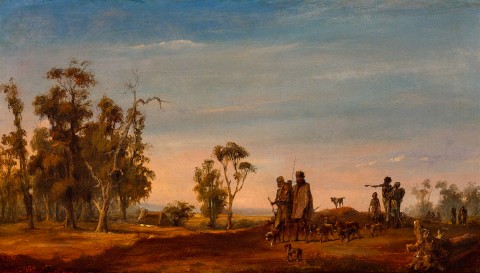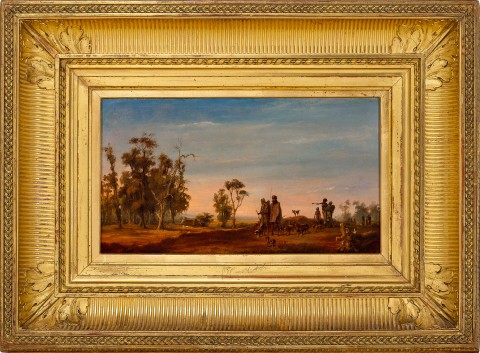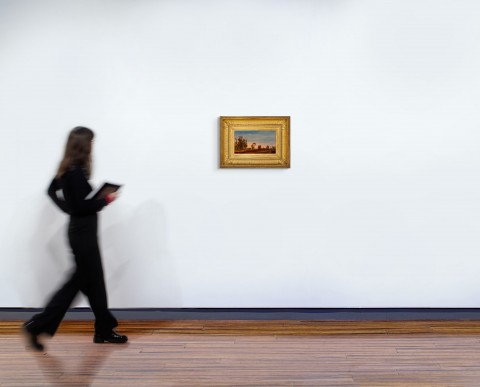[Aboriginal group on the tramp, towards evening], 1851
Alexander Schramm
oil on canvas
19.5 x 35.5 cm
signed and inscribed lower left: A. Schramm / Adelaide 1851
Adrian Mibus and Louise Whitford, Whitford Fine Art, London and Brussels
Private collection, Adelaide, acquired from the above c.1980s
Of all Australia’s colonial artists who took on the challenge of portraying Aboriginal people, whether sympathetically or not, one stands out as particularly difficult to categorise. Arriving in Adelaide from Hamburg aboard the Prinzessin Victoria Luise on 7 August 1849, Carl Friedrich Alexander Schramm was aged 36. The son of a Berlin book dealer, Schramm had studied art in that city and had painted in Italy and Poland. His Boating Party at Treptow, 1838 conforms to a particular variant of Biedermeier art, with ‘theatrical staging, narrow proscenium-like foregrounds and flat patterning that often suggest scenic decoration.’1 Enough survives of Schramm’s German output to indicate that he had begun producing artworks with a sharpened critique of the false ‘idyll’ which Biedermeier art often portrayed. Indeed, his work may well have attracted the attention of German authorities, perhaps accounting for his presence on the Prinzessin Victoria Luise whose passenger list included sympathisers with the 1848 uprisings.
Those hints of Schramm’s attitude become more evident when we turn to his Australian output. His first Australian painting, perhaps the most ambitious of his career, was a large and detailed portrayal of an encampment of Murray River Aboriginal people on the northern bank of the River Torrens – Adelaide: A Tribe of Natives on the Banks of the Torrens, 1850 (National Gallery of Australia). These people had been attracted to the city by the government ration distribution but had outlived their welcome; the camp housing more than 80 people was soon regarded as a public nuisance. Schramm’s picture presented an alternative view of a complex and ebullient sociality. In its crowded but clear delineation it was not so far removed from the Boating Party at Treptow.
That benchmark oil painting established Schramm’s reputation, and he was to paint similar tableaux of multiple Aboriginal figures and scenes within scenes, as if the colonial world had been pushed back and made irrelevant. These sold well, won prizes at the Society for Arts annual shows, and lithographs followed. As these large encampments fragmented, Schramm might well have turned to more lucrative society portraiture, yet he persisted. He did not completely abandon his Biedermeier style – his Bush Visitors series, 1858 – 1860 conveys the same theatrical impression with bright colouring and distinct figuring, but he had also found another way to approach his subject, applying an acid, sardonic critique to the unfolding predicament of a colonised people dealing with their own displacement and emasculation.
In 1851, barely a year after Adelaide: A Tribe of Natives on the Banks of the Torrens, Schramm produced the work under consideration here. A straggling trail of partly clothed Aborigines with their dogs enters the field of view, arriving at the edge of settlement at sunset. One figure gestures towards a small cottage on a riverbank, overlooked by ragged eucalypts. Individual features are blurred by the sun’s glare, shifting the painting’s register from descriptive to allegorical. The group has arrived at the edge of the colony, and we are all familiar with the consequences.
[Aboriginal group on the tramp, towards evening], 1851 is perhaps the first colonial painting to steer a course past the literal, the ethnographic, the scenic, into the core of the colonial impasse. Using variants on this theme in sketches, lithographs and oil paintings, Schramm would confront this impasse repeatedly over the following decade until his death in 1864, aged 51.
1. Boime, A., ‘Biedermeier culture and the revolutions of 1848’ in Art in an age of civil struggle 1848 – 1871, University of Chicago Press, Chicago, 2007, p. 471
PHILIP JONES


